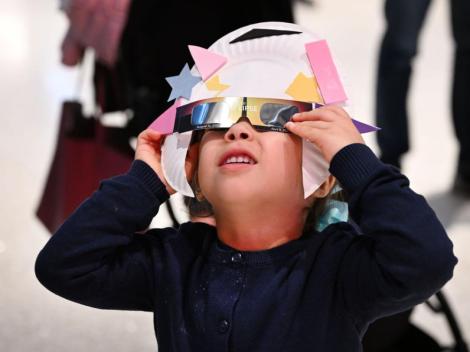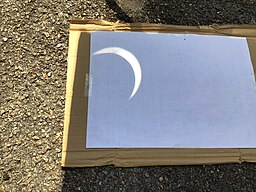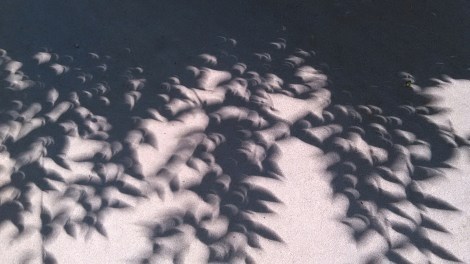
(This post is updated from a post from 2017)
For those of us in North America, Monday, April 8, 2024 will offer a rare chance to see a solar eclipse across the continent. While some a total eclipse, if the weather cooperates, everyone on the continent will see at least a partial eclipse.
Eclipses are relatively rare and fascinating events. I still remember vividly seeing a partial eclipse in 1984 when I was 9. It made me think about the world and the universe a little differently. I’ve loved eclipses ever since, and though I’ve never seen a full eclipse, I always try to get outside to observe partial eclipses.
This brings us to the question of how to best view an eclipse, or more specifically how to help our children observe the eclipse. Looking directly at the sun without protection, even during an eclipse (maybe especially during an eclipse) is dangerous and can easily damage your vision. Given how important we all know vision is, and how much we’ve invested in our children’s vision, I wanted to share some information about safely viewing the eclipse.
I talked with Dr. Nate Bonilla-Warford a pediatric optometrist in Tampa, FL ], in 2017 before another full eclipse, about his thoughts on children viewing the eclipse. He said:
“An eclipse is an exciting event for the entire family. As long as you and your children are prepared ahead of time with proper viewing equipment, practice, and instruction to never look directly at the sun, there is very low risk of eye problems. If you are concerned about vision problems after the eclipse, vision your eye doctor.”
You can hear more from Dr. Nate on his 2017 podcast, about eclipse safety.
There are safe and not-safe ways to view the eclipse
As mentioned before, looking at the sun without protection will damage your child’s eyes (and your eyes). Usually, the brightness of the sun will trigger a reflex that keeps you from looking directly at it, however, during the eclipse, the sun will be less bright and it may feel more comfortable to look at the sun. The backs of our eyes do not have pain sensors, so there’s no feedback telling you to look away if damage is occurring. And damage, known as solar retinopathy, does occur from looking directly at the sun.
For any eclipse viewing, make sure that you supervise your child and that you emphasize to them how important it is that they not look directly at the sun. You know your child best, if they are likely to try to stare at the sun, maybe directly observing the eclipse outside isn’t the right activity for them. Luckily, there’s some great ways to observe the eclipse without looking at the sun.
Looking at the sun during an eclipse – safely!
If you and your child want to observe the eclipse by looking at the sun, you must use solar safe viewing glasses (“eclipse glasses”) before and after totality.
According to the NASA Eclipse Safety Page:
“You can view the eclipse directly without proper eye protection only when the Moon completely obscures the Sun’s bright face – during the brief and spectacular period known as totality. (You’ll know it’s safe when you can no longer see any part of the Sun through eclipse glasses or a solar viewer.).
“As soon as you see even a little bit of the bright Sun reappear after totality, immediately put your eclipse glasses back on or use a handheld solar viewer to look at the Sun.”
First, it is critical to make sure that the glasses you have are compliant with the ISO 12312-2 international safety standard. If they are the right kind of glasses, you will not be able to see through them at all when you aren’t looking at the sun. The American Astronomical Society has a list of suppliers of safe eclipse glasses
For kids who wear glasses, the eclipse glasses should go over their regular glasses. It may be easiest for them to just hold the glasses up to their eyes rather than try to wear them over their glasses. Practice this out before the eclipse.
You can cut out a paper plate around the glasses to make them easier for your child to hold up to their eyes and make it less likely that they’ll peek around at the sun. Find instructions from NASA here.

Some of the best ways of observing the eclipse don’t involve looking directly at the sun at all.
Pinhole projectors

Making a pinhole projector is easy and it lets you see the changes in the sun during the eclipse safely as you are looking at a projection of the sun.
- NASA has a page with instructions and printable pdfs to use to make different pinhole projectors at home.
- The Jet Propulsion Laboratory also has step by step instructions.
- University of Illinois has instructions to make a couple of different types of viewers, from cereal box or a cardboard tube.
Looking at shadows cast by trees

I’m including this mostly because it blew my mind as a kid. The sun shining through leaves on the trees makes a natural pinhole projector – you can see the shape of the eclipse in the shadows.
The science blog, Last Word on Nothing has a great explanation of this.
Visit your local observatory.
If you live near an observatory, many will have public events (though they’ll probably be very crowded) and many will have other solar viewers that let you view the eclipse safely, often in much greater detail than you’d be able to see on your own. Plus, there will be astronomers and teachers there to give you more information during the event.
Happy eclipse viewing!
